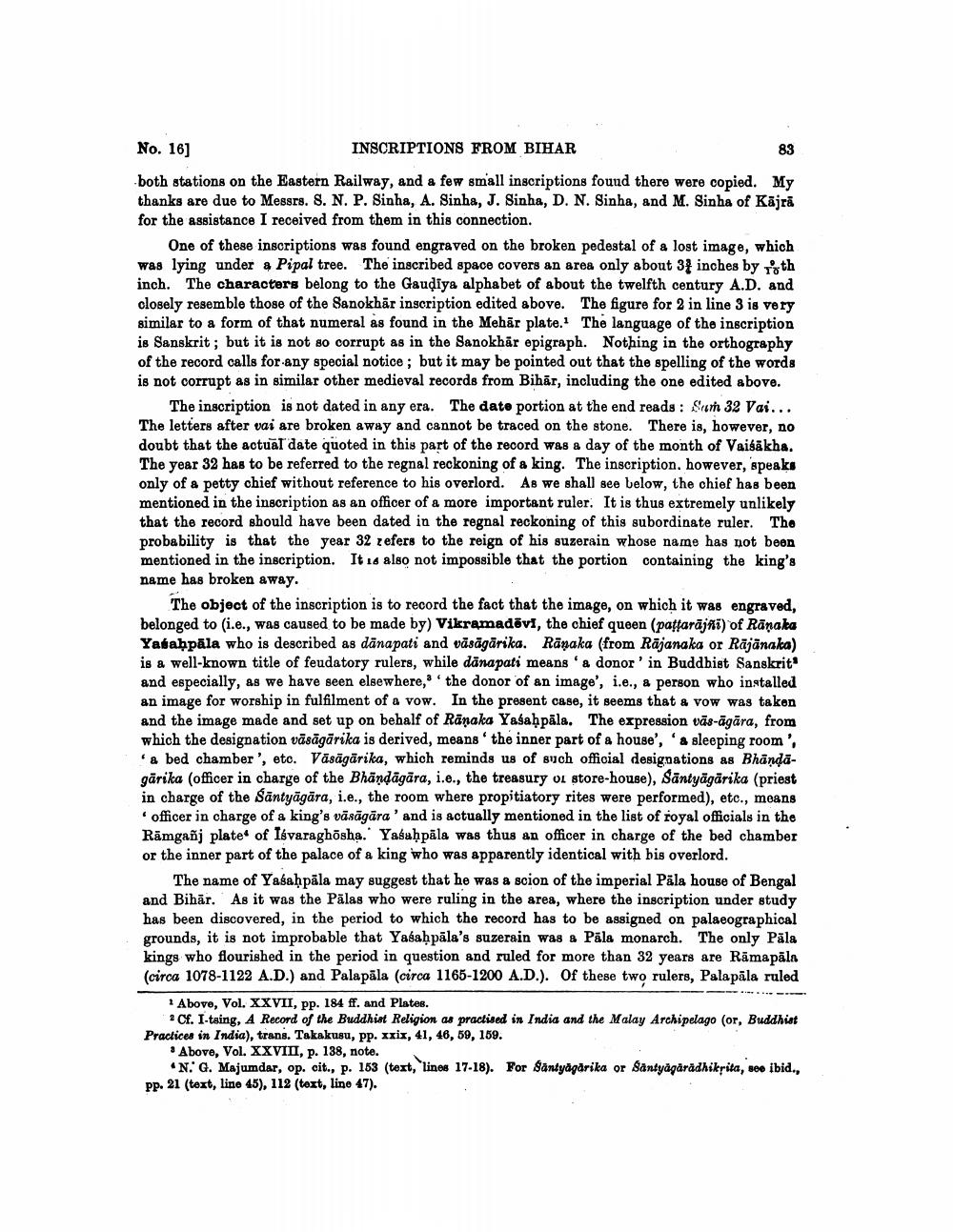________________
No. 16]
INSCRIPTIONS FROM BIHAR both stations on the Eastern Railway, and a few small inscriptions found there were copied. My thanks are due to Messrs. S. N. P. Sinha, A. Sinha, J. Sinha, D. N. Sinha, and M. Sinha of Kājrā for the assistance I received from them in this connection.
One of these inscriptions was found engraved on the broken pedestal of a lost image, which was lying under & Pipal tree. The inscribed space covers an area only about 34 inches by rxth inch. The characters belong to the Gaudiya alphabet of about the twelfth century A.D. and closely resemble those of the Sanokhār inscription edited above. The figure for 2 in line 3 is very similar to a form of that numeral as found in the Mehār plate. The language of the inscription is Sanskrit ; but it is not so corrupt as in the Sanokhär epigraph. Nothing in the orthography of the record calls for any special notice ; but it may be pointed out that the spelling of the words is not corrupt as in similar other medieval records from Bihār, including the one edited above.
The inscription is not dated in any era. The date portion at the end reads: Siem 32 Vai... The letters after vai are broken away and cannot be traced on the stone. There is, however, no doubt that the actual date quoted in this part of the record was a day of the month of Vaisakha. The year 32 has to be referred to the regnal reckoning of a king. The inscription, however, speaks only of & petty chief without reference to his overlord. As we shall see below, the chief has been mentioned in the inscription as an officer of a more important ruler. It is thus extremely unlikely that the record should have been dated in the regnal reckoning of this subordinate ruler. The probability is that the year 32 zefers to the reign of his suzerain whose name has not been mentioned in the inscription. It is also not impossible that the portion containing the king's name has broken away.
The object of the inscription is to record the fact that the image, on which it was engraved, belonged to (i.e., was caused to be made by) Vikramadāvi, the chief queen (pattarājai) of Rānaka Yabahpāla who is described as dānapati and vāsāgārika. Rāņaka (from Rājanaka or Rājānaka) is a well-known title of feudatory rulers, while dānapati means 'a donor' in Buddhist Sanskrit and especially, as we have seen elsewhere, the donor of an image', i.e., & person who installed an image for worship in fulfilment of a vow. In the present case, it seems that a vow was taken and the image made and set up on behalf of Ranaka Yaśahpāla. The expression vās-āgāra, from which the designation vāsāgārika is derived, means the inner part of a house', 'a sleeping room',
a bed chamber', etc. Vāsāgārika, which reminds us of such official designations as Bhandagārika (officer in charge of the Bhāndāgāra, i.e., the treasury Ol store-house), Santyāgārika (priest in charge of the Santyāgāra, i.e., the room where propitiatory rites were performed), etc., means
officer in charge of a king's vāsāgāra' and is actually mentioned in the list of royal officials in the Rāmgañj plate of Isvaraghosha. Yasahpāla was thus an officer in charge of the bed chamber or the inner part of the palace of a king who was apparently identical with his overlord.
The name of Yaśaḥpāla may suggest that he was a scion of the imperial Păla house of Bengal and Bihār. As it was the Pālas who were ruling in the area, where the inscription under study has been discovered, in the period to which the record has to be assigned on palaeographical grounds, it is not improbable that Yasahpāla's suzerain was a Pāla monarch. The only Pāla kings who flourished in the period in question and ruled for more than 32 years are Rāmapāla (circa 1078-1122 A.D.) and Palapāla (circa 1165-1200 A.D.). Of these two rulers, Palapāla ruled
1 Above, Vol. XXVII, pp. 184 ff. and Plates.
1 Cf. I-tsing, A Record of the Buddhist Religion as practised in India and the Malay Archipelago (or, Buddhist Practices in India), trans. Takakusu, pp. xxix, 41, 46, 59, 169.
* Above, Vol. XXVIII, p. 138, note.
.N. G. Majumdar, op. cit., p. 153 (text, lines 17-18). For Säntyagarika or Santyagaradhikrita, see ibid., Pp. 21 (text, line 45), 112 (text, line 47).




